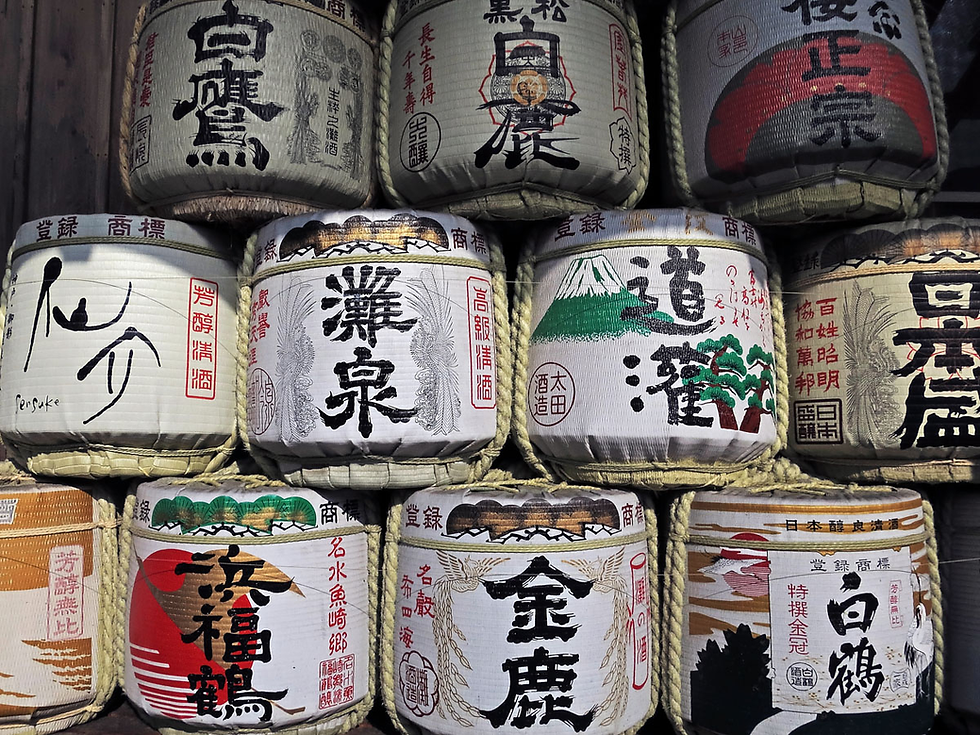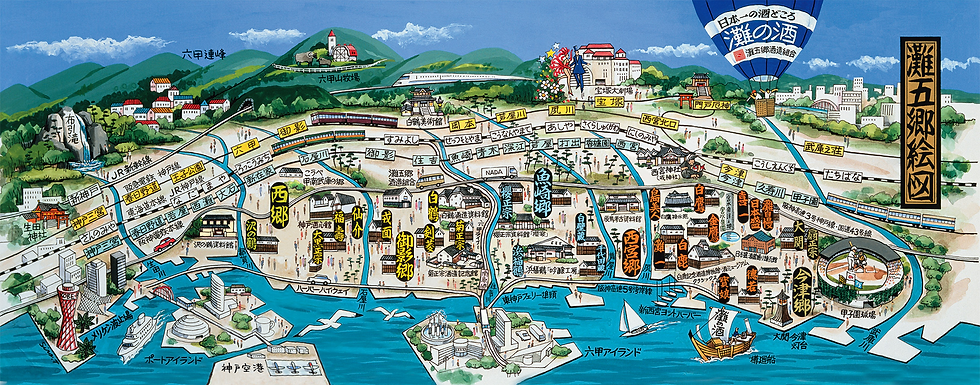Sake, Chinatown Flavors, and Waterfront Views in Kobe | MK Travel
- M.R. Lucas
- Jul 24
- 4 min read
Updated: Aug 13

Enjoy centuries-old sake in Nada. Stroll through Kobe’s resilient Chinatown. Watch the sunset behind Port Tower at Meriken Park. MK’s Mini Gourmet Course invites you to explore Kobe through its flavors, textures, and the spirit of international exchange. This curated 5.5-hour journey blends sacred brews, fusion cuisine, and seaside serenity into one unforgettable experience—guided by expert drivers and filled with hospitality.
Nada Sake District: Sip with Reverence

Sake is more than Japan’s national drink; it embodies time, tradition, and regional character. The best place to experience its true essence is in Nada Sake District, located just east of Kobe in Hyogo Prefecture.
Nada, one of Japan’s leading sake-producing regions, has a long history of fermentation innovation. Its success stems from a unique combination of natural resources: miyamizu, mineral-rich groundwater from nearby Mt. Rokko; Yamada Nishiki, a high-quality sake rice grown in the region’s fertile soil; and the rokkō oroshi, seasonal winds from the mountains that cool the steamed rice during brewing. These factors, along with the region’s proximity to the Seto Inland Sea—which facilitates shipping and trade—enabled Nada to become a major brewing center during the Edo period.
By the 18th century, Nada was responsible for producing over 80% of the sake consumed in Edo (now Tokyo). Both shoguns and common people enjoyed its sake. Today, Nada still contributes over 25% of Japan’s total sake production, solidifying its status as a vital hub in the industry.

Nada-ku, one of Kobe’s nine wards, has a 12-kilometer stretch extending from Kobe’s eastern edge to Nishinomiya. It includes five distinct brewing districts: Nishi-go, Mikage-go, Uozaki-go, Nishinomiya-go, and Imazu-go. Together, they are home to around 25 breweries, ranging from well-known names like Hakutsuru and Kikumasamune to smaller, family-run businesses with centuries of experience.
Whether you're a seasoned sake connoisseur or a curious first-timer, Nada offers a rare chance to taste, learn about, and observe the brewing process firsthand. Many breweries in the area feature museums, tasting rooms, and factory tours, showcasing both traditional and modern methods of sake production. The blend of heritage and hospitality is part of what makes the district a national treasure—even as domestic consumption declines, international interest continues to grow.
So come, set the record straight. Rediscover what the Japanese have known for centuries: that sake, when treated with respect, can elevate a meal, create a memory, or mark a moment in time.
Kobe Chinatown (Nankinmachi): Fusion and Fire

One among Japan’s three main Chinatowns—Yokohama’s sprawling area and Nagasaki’s historic site—Kobe’s Nankinmachi distinguishes itself with its intimate charm, vibrant culinary scene, and resilience that embodies the spirit of the city itself.
Just 270 meters long, this vibrant corridor of lanterns, pork buns, and red-painted gates captures centuries of cultural fusion within a few busy blocks. But it wasn’t always this way.
Nankinmachi was founded in the 1860s, when Chinese immigrants—once restricted from the official foreigner zone—were granted a small piece of land west of Kobe’s port. They established food stalls, butcher shops, and storefronts. By the early 20th century, it had become a bustling marketplace where Chinese, Japanese, and Westerners mingled. Then came the bombs.
WWII devastated the district. In the tough postwar years, it became a hidden bar neighborhood—until 1977, when community-led renewal revitalized it. Gates were restored. Lanterns were hung. The spirit of the place came back. Even the 1995 Great Hanshin Earthquake couldn’t wipe it out.

Today, more than 100 shops offer shumai, steamed buns, Sichuan skewers, and matcha sweets. It’s a curated experience—an echo of China with Kansai flavor. At its core is Kobe Kanteibyo, a Taoist temple where Guan Yu is honored, incense coils rise in prayer, and prosperity is still pursued through old rituals.
This isn’t just a spot to snack. It’s a place that endures, evolves, and honors every bite.
Meriken Park: Harbor Reflections

When Japan opened its doors to the world in the late 19th century, Kobe served as the gateway. American consulates appeared alongside merchant ships, and soon the locals referred to the port as Meriken Wharf—a Japanified version of “American.”
Now, Meriken Park is more than just a wharf. It’s Kobe’s sleek, modern waterfront. A promenade where couples walk, kids fly kites, and tourists take sunset photos under neon signs. But beneath its charming surface lies a deeper history.
The park spans 15.6 acres, offering panoramic views of the bay with the sea on one side and Mt. Rokko’s lush outline on the other. Notable structures include the Port Tower, the Maritime Museum, and the glowing “BE KOBE” sculpture, a popular photo spot for couples and travelers alike.

At the eastern edge, a memorial to the 1995 Hanshin Earthquake stands as a poignant reminder of what once fell and was rebuilt. Nearby, cafes, boutique hotels, and public art give the park an almost European feel. It’s a place to slow down and experience Kobe’s cosmopolitan pace—urban, coastal, and purposeful.
Whether you come for the views or stay for the stories, Meriken Park is the calm after the cultural storm.
Let MK Take You There
This isn’t just a brief course; it’s a carefully curated glimpse into Kobe’s diverse culture: timeless sake traditions, a Chinese-Japanese fusion rooted in survival, and a bayfront that encourages reflection. It provides a snapshot of Japan at its most global—and most intimate. Let MK lead the way. From welcoming hospitality to smooth logistics, your only concern will be whether to indulge in that extra pork bun.

Image Credits
Image from Feel Kobe Official Website
Aiko99ann, CC BY-SA 3.0, via Wikimedia Commons
Image from Hanshin Electric Railway – Nada Sake Brewery Tour
Zairon, CC BY-SA 4.0, via Wikimedia Commons
JthomasP, CC BY-SA 4.0, via Wikimedia Commons
本人撮影, CC BY-SA 3.0, via Wikimedia Commons



Why Choose UNICCM? Learn at your own pace, from anywhere; real-world industry professionals with real-world experience; certifications that employers value and trust. Invest in your future today!
شيخ روحاني
رقم شيخ روحاني
شيخ روحاني لجلب الحبيب
الشيخ الروحاني
الشيخ الروحاني
شيخ روحاني سعودي
رقم شيخ روحاني
شيخ روحاني مضمون
Berlinintim
Berlin Intim
جلب الحبيب
https://www.eljnoub.com/
https://hurenberlin.com/
youtube